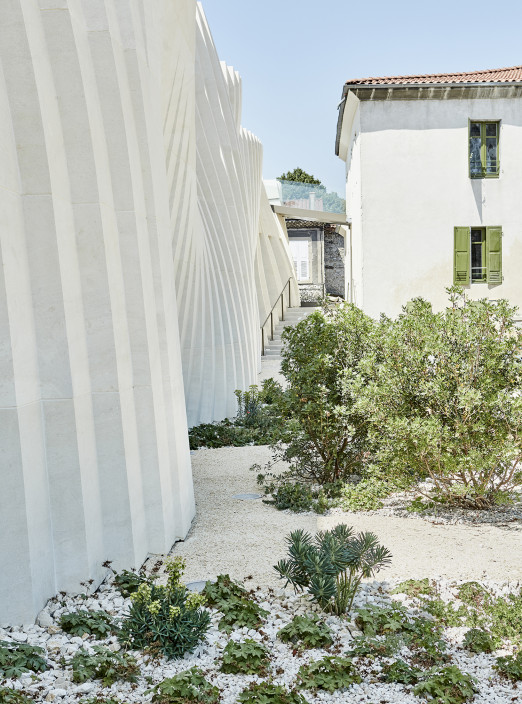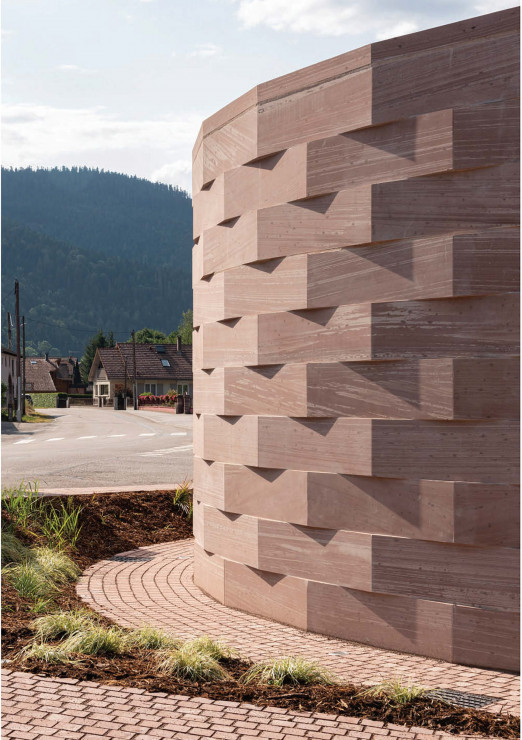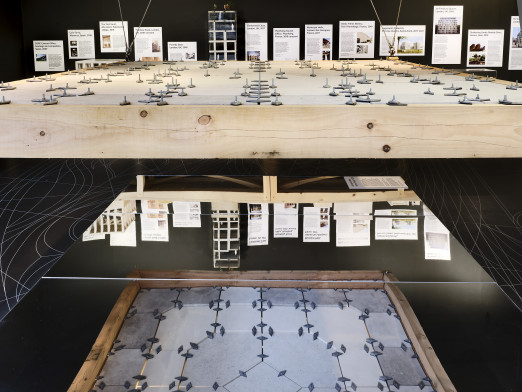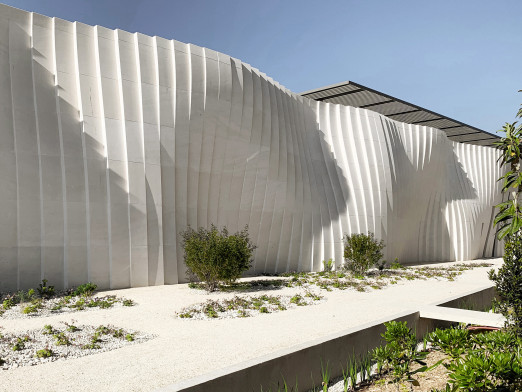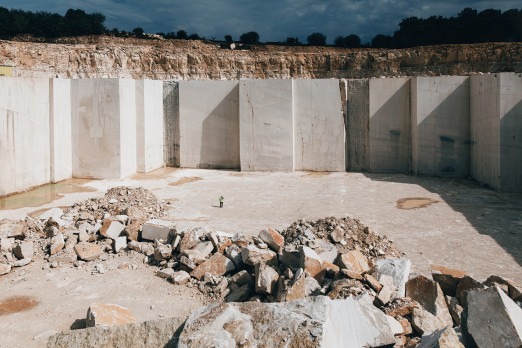As part of the New Stone Age exhibition we share The Stone Tower Research Project report, exploring the economic, sustainability and practicalities of stone. You can also download the report summary.
1.0. Summary
1.1. This paper looks at the comparative cost, programme and embodied CO2 for a notional commercial office tower.
It has been assumed that the tower is 30 storeys with a total Gross Internal Floor area of 37,800 m² / 406,875 ft².
Cost Consultants – Jackson Coles
Sustainability – Eight Associates
Structural Engineering – Webb Yates
Construction Methodology – The Stonemasonry Company Ltd
Supplier – Polycor
Architecture – Groupwork
1.2. For comparison purposes the following structural solutions have been considered;
i. Stone exoskeleton + Stone Cores + Floors
ii. Stone exoskeleton + CLT Cores + Floors
iii. Steel frame + Concrete Core + LW Steel/Concrete deck + concrete topping
iV. Concrete frame + Concrete Core + concrete topping
2.0. Purpose of Research
To investigate whether large scale commercial buildings can be built with stone superstructures, stone and or timber floor plates to meet the same criteria of optimum office space and building height as steel and concrete structures and be the same or lower in construction cost and carbon footprint?
3.0. Setting an Outline Brief for Commercial Office Space
Optimised Area Requirement; with the help of some of the UK’s leading commercial space developers we asked for a brief that would optimise the ideal column free floor spans with internal flexibility for speculative office leased spaces. If they were to be achieved in one building the ideal net internal area per floor, ratio for gross to accommodate vertical circulation and amenities and in turn the optimum overall building area and therefore height? The 30 storey tower outline brief received, includes taller ground and rooftop levels for mechanical services split across roof and basement with the remainder of the roof for amenity space. 28 above ground floor are column free open plan office floor plates.
4.0. Method
4.1. Exoskeleton Structure
A stone exoskeleton is used for quicker erection on site and allowing a curtain wall to sit 200mm from it so that both weathering and thermal performance remains high without the need for window interfaces and thermal bridging points. In turn leaving the envelope as high performance and lower in cost.
4.2. Stone and or CLT Floor slabs
Stone/post-tensioned 14m by 1.5m prefabricated floor slabs span from the central core to a perimeter ring beam connecting to the exoskeleton at one end. Alternatively, CLT spans in single planks to a ring beam picked up by the exo-skeleton.
4.3. Central Core
Core can be formed of stacked stones as there are no internal thermal criteria or CLT.
4.4. Type of Stone
Granite or basalt can used for their ability to withstand and retain structural integrity in the event of a fire, availability, cost effectiveness, aesthetic and textural qualities.
4.5. Fire Performance
Basalt was tested at the BRE fire testing facility during 2019 under the following conditions;
i. One side engaged with a thermal envelope and lined in plasterboard
ii. Two sides engaged with the thermal envelope and lined in plasterboard
iii. Disengaged column exposed to the elements as an exoskeleton and therefore exposed on all sides to fire.
Option iii performed best for longest reinforcing the exoskeleton as not only faster and cheaper to build with better weathering and thermal performance but also fire duration.
4.6. Environmental Performance
The distance of the exoskeleton from thermal envelope/ glazing line can be set by the latitude the building is to be developed as the beam line of the exoskeleton will act as a brise soleil cutting out the worst part of the summer sun but allowing it in the colder months, reducing energy consumption.
5.0. Conclusions
5.1. Cost (See appendix 6.1 Cost Comparison by Jackson Coles)
5.1.1. Inherently stone extraction, preparation, delivery and erection on site of an exoskeleton and core can be around 25% of that for a steel or concrete frame structure. Jackson Coles analysis of the market conditions with respect to availability of large-scale suppliers, installers and their relationship with respect ohpp to main contractors closes such savings. While the cost of the material and its erection on a 30 storey structure is estimated to be marginally greater than steel or concrete, it is the inherent finish of the stone which then saves considerably on the overall cost outcome as both steel and concrete would have to fireproofed, weathered, insulated then clad with stone veneers. These later processes adding capital cost and time on site while a load bearing stone exoskeleton is essentially already self-finished. Furthermore the glazing system / curtain wall sat behind the exoskeleton will not need to perform the same high level of “finish” function as the glazing and stone cladding system attached to a steel or concrete frame. As the exoskeleton also acts as a brise soleil the glazing performance can be lighter as can the MEP systems as less energy is required for cooling in summer.
5.1.2. Prefabricated pre-tensioned floor slabs – similarly, while the capital cost of a single plank is higher than a hollow core slab, the clean and level finish and density of the stone means no binding or screed topping is required. Saving on this cost, programme and load requirement of the building.
5.2. Optimisation
While placing the superstructure to the outside has multiple cost and thermal performance benefits it also allows for column free spaces within. However, the area and flexibility gained can be argued to have been placed at the perimeter of the wall. That is, if the building sits across 100% of the site boundary (not often permissible) then the exoskeletal and thermal envelope build-up have not gained extra internal area to lease but have at least allowed for clear column free floors.
5.3. Sustainability (see 6.2 Embodied CO2 by Eight Associates)
5.4. Stone alone
Inherently stone has zero carbon footprint. It is the energy used in quarrying, preparing and lifting the stone into place where CO2 builds up. Typically, if the quarry is in the same country then the stone superstructure will have saved 95% of the embodied CO2 against its steel or concrete equivalent. If the stone needs to be shipped in from abroad the saving may reduce to 80% or 70% for Europe and Asia/America respectively. If the stone is especially hard and deep within a quarry the saving will reduce to 60%. Even at 60% these are undoubtedly considerable savings which would far exceed the those expected of the industry as part of wider attempts to lower CO2 emissions.
5.5. Stone + CLT
As timber has carbon sequestration properties, combining stone as exo-skeletal superstructure and CLT floor plates and core will produce a CO2 negative building today. Again a far leap ahead of the carbon neutral ambition for the industry for thirty to fifty years’ time.
6.0 Appendices
6.1. Cost Comparison by Jackson Coles
6.2. Embodied CO2 by Eight Associates
The Stone Tower research project is exhibited in the New Stone Age, an exhibition and associated public programme curated by the Building Centre exhibitions team with Amin Taha + Groupwork, Steve Webb and Pierre Bidaud. Supported by the Built Environment Trust.
We would like to thank our headline sponsors Polycor and The Stonemasonry Company Ltd.




